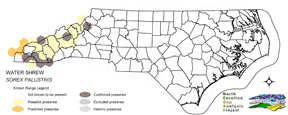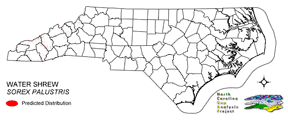
| Taxa: |
| Order: |
| Family: |
| Mammalia |
| Insectivora |
| Soricidae |
| NatureServe Global Rank: |
| NatureServe State (NC) Rank: |
| G5 |
| S2 |
| Federal Status: |
| NC State Status: |
| --- |
| --- |


| Land Unit |
| US Fish & Wildlife Service |
| US Forest Service |
| US National Park Service |
| US Department of Defense |
| NC State Parks |
| NC University System |
| NC Wildlife Res. Com. |
| NC Forest Service |
| NC Div. of Coastal Mgmt. |
| Local Governments |
| Non-Governmental Org. |
| Other Public Lands |
| Private Lands |
| GAP Status 1-2 |
| All Protected Lands |
| Statewide |
| Hectares |
| 0.00 |
| 7,328.07 |
| 0.00 |
| 4,839.93 |
| 3.60 |
| 0.00 |
| 49.14 |
| 0.00 |
| 0.00 |
| 286.29 |
| 382.23 |
| 0.00 |
| 7,551.27 |
| 6,309.36 |
| 12,883.50 |
| 20,440.53 |
| Acres |
| 0.00 |
| 18,108.05 |
| 0.00 |
| 11,959.73 |
| 8.90 |
| 0.00 |
| 121.43 |
| 0.00 |
| 0.00 |
| 707.44 |
| 944.51 |
| 0.00 |
| 18,659.59 |
| 15,590.77 |
| 31,835.82 |
| 50,509.64 |
| % of Dist. on |
| Prot. Lands |
| 0.0 % |
| 56.9 % |
| 0.0 % |
| 37.6 % |
| < 0.1 % |
| 0.0 % |
| 0.4 % |
| 0.0 % |
| 0.0 % |
| 2.9 % |
| 2.9 % |
| 0.0 % |
| 0.0 % |
| 49.0 % |
| ----- |
| ----- |
| % of Dist. on |
| All Lands |
| 0.0 % |
| 35.9 % |
| 0.0 % |
| 23.7 % |
| < 0.1 % |
| 0.0 % |
| 0.2 % |
| 0.0 % |
| 0.0 % |
| 1.4 % |
| 1.9 % |
| 0.0 % |
| 36.9 % |
| 30.9 % |
| ----- |
| ----- |
|
This species is known only to occur in Clay County within North Carolina (Webster et al. 1985). S. palustris likes herbaceous covered banks of swift flowing streams and creeks (Webster et al. 1985). Often associated with grass-sedge-willow, or some combination thereof, vegetated shorelines of mountain streams (Whitaker and Hamilton 1998). Conditions around beaver ponds and broadened slower-moving lengths of streams are also suitable habitat for this shrew. Also, found in bogs, intermittent creek beds, muddy grass-choked spring heads and rocky areas near water. NATURE SERVE GLOBAL HABITAT COMMENTS: Most abundant along small cold streams with thick overhanging riparian growth. Also around lakes, ponds, marshes, bogs, and other lentic habitats. Rarely far from water. Nest sites are near water in underground burrows, rafted logs, beaver lodges, and other areas providing shelter. Van Zyll de Jong (1983) described the habitat in Canada: 'Lakes, ponds, swift and sluggish small streams, all provide suitable habitat if adequate cover is available in the form of overhanging banks, boulders, tree roots, logs, etc. In the mountains, the species occurs along cold fast mountain streams. On the other extreme, it is also found in stagnant water of marshes or bogs, and a few have been caught in places with very little water. The water shrew appears to have some flexibility in adapting to habitats with little water or even to habitats where water is present only seasonally. However, the species appears to be most abundant along cold mountain streams with abundant cover.' Pagels (1990, 1991) noted that in the southern Appalachians the water shrew is limited to prime habitat: 'high elevation situations where moist, cool, shaded situations have prevailed throughout historic time...elevations ranging from about 762 m (2500 ft.) in Pennsylvania to 1158 m (3800 ft.) and above in North Carolina and Tennessee. In addition to close proximity to water, habitat features often include moss-covered rocks, crevices, fallen trees, and boulder-strewn and/or overhanging stream banks. Understory vegetation is generally dense with mountain laurel and rhododendron being the most abundant species.' In Montana, Conaway (1952) examined 101 capture sites and found typical habitat to be 'along fast cold mountain streams having banks which offered favorable cover.' All these shrews were trapped within 18 cm (7 inches) of water. Though normally associated with water, water shrews 'have been found more than 100 m (328 ft.) from streams in mature northern hardwood stands in northern New Hampshire' (DeGraaf and Rudis 1986). This and other captures far from water probably represent dispersing individuals. |
| Code | Name | Description | NC Natural Heritage Program Equivalent |
| 267 | Riverbank Shrublands | Riverside shrubs with temporarily flooded hydrologies. Found in the both the Mountains and Piedmont. Containing dominants such as smooth alder and a Carolina or black willows. | Sand and Mud Bar |
| 269 | Floodplain Wet Shrublands | Saturated shrublands of the Piedmont, includes buttonbush, swamp-loosestrife, decodon and alders. | Piedmont/mountain Semipermanent Impoundment |
| 230 | Piedmont Mesic Forest | American Beech - Red Oak - White Oak Forests. | Mesic Mixed Hardwood |
| 384 | Piedmont/Mountain Mixed Bottomland Hardwood Forests | Includes temporarily to seasonally forests dominated by hardwood species. Hardwoods include sweetgum, red maple, sycamore which co-occur in a mosaic of bottomland and levee positions. Includes alluvial hardwood forests in the mountains. Hemlock and white pine may occur as inclusions, but are generally mapped separately. | Piedmont/Mountain Alluvial Forest, Piedmont/Mountain Levee Forest |
| 517 | Hemlock Floodplain Forest | Alluvial forest with hemlock and/or white pine in mountains and western piedmont. Hydrology is generally temporarily to seasonally flooded. | Canada Hemlock Forest |
| 521 | Spruce/Fir Forest | High Elevation Frazer-Fir - Red Spruce, Red Spruce and Red-Spruce-Yellow Birch Forests. Tree densities included here include both woodland to forest density. Highly intermixed with Northern Hardwoods, Grassy Balds, and Shrub Balds. | Red Spruce--Fraser Fir Forest, Fraser Fir Forest |
| 522 | Northern Hardwoods | High Elevation forests including yellow birch, American beech, and yellow buckeye. Includes forests with Hemlock and Yellow Birch. | Northern Hardwoods Forest, Boulderfield Forest |
| 525 | Appalachian Oak Forest | A variety of oak forest types including Black, White, Scarlet Oaks in dry to mesic situations. Includes forests historically co-dominated by American Chestnut. | High Elevation Red Oak Forest, Montane White Oak Forest |
| 526 | Appalachian Cove Forest | Mixed Mesophytic forests of the mountains. Includes tuliptree, basswood, yellow buckeye and surgar maple. This class is mapped to include cove forests dominated or co-dominated by hemlock. | Rich Cove Forest, Acidic Cove Forest |
| 527 | Appalachian Hemlock | Upland hemlock forests of the moutains region. Vary from side slopes to steep slope positions. | Canada Hemlock Forest |
| 533 | Appalachian Swamp Forest | Evergreen and deciduous forests with saturated hydrologies. This class may contain a variety of trees species, including hemlock - red maple, pitch pine, and white pine forests. | Swamp Forest-Bog Complex, Southern Appalachian Bog, Southern Appalachian Fen |
| 534 | Appalachian Wet Shrubland/ Herbaceous | Saturated shrubs and herbaceous vegetation. Often mapped as an inclusion in Appalachian Swamp Forest. | Southern Appalachian Bog, Southern Appalachian Fen |
|
Wrigley, R.F., J.E. DuBois, and H.W. Copland. 1979. Habitat, abundance and distribution of six species of shrewsin Manitoba. J. Mamm. 60:505-520.
George, S. B. 1988. Systematics, historical biogeography, and evolution of the genus SOREX. J. Mammalogy 69:443-461. Jackson, H. H. T. 1928. A taxonomic review of the American long-tailed shrews (genera SOREX and MICROSOREX). North American Fauna 51:1-238. Churchfield, S. 1992. The Natural History of Shrews. Cornell University Press, Ithaca, New York. 192 pp. Jones, J. K., Jr., et al. 1992. Revised checklist of North American mammals north of Mexico, 1991. Occas. Pap. Mus., Texas Tech Univ. (146):1-23. Master, L. L. 1978. A survey of the current distribution, abundance, and habitat requirements of threatened and potentially threatened species of small mammals in Michigan.Mich. DNR Endg. Sp. Prj. Rept. No. E-1-2, Study 703. Pagels, J. F. 1990. Water shrew study progress report. Report submitted to Virginia Deptartment of Game and Inland Fisheries, Richmond, Virginia. Unpublished. Wilson, D. E., and D. M. Reeder (editors). 1993. Mammal Species of the World:a Taxonomic and Geographic Reference. Second Edition. Smithsonian Institution Press, Washington, DC. xviii + 1206 pp. Whitaker, J.O. Jr. and W.J. Hamilton, Jr. 1998. Mammals of the eastern United States. Cornell Univ. Press, Ithaca, New York. 583 pp. Conaway, C. H. 1952. Life history of the water shrew (Sorex palustris navigator). Am. Midl. Nat. 48:219-247. Buckner, C.H. 1966. Populations and ecological relationships of shrews in tamarack bogs of southeastern Manitoba. Jour. Mamm. 47(2):181-194. Banfield, A.W.F. 1974. The mammals of Canada. University of Toronto Press, Toronto. Godin, A.J. 1977. Wild Mammals of New England. Johns Hopkins University Press, Baltimore. 304 pp. Hamilton, William J., Jr., and John O. Whitaker, Jr. 1979. Mammals of the eastern United States. Cornell Univ. Press, Ithaca, New York. 346 pp. Hall, E. R. 1981. The Mammals of North America. Second edition. 2 Volumes. John Wiley and Sons, New York, New York. Junge, J. A., and R. S. Hoffmann. 1981. An annotated key to the long-tailed shrews (genus SOREX) of the United States and Canada, with notes on the Middle American SOREX. Occas. Pap. Univ. Kansas Mus. Nat. Hist. 94:1-48. Baker, Rollin H. 1983. Michigan mammals. Michigan State University Press. 642 pp. van Zyll de Jong, C. G. 1983. Handbook of Canadian Mammals. 1. Marsupials and insectivores. Nat. Mus. Canada, Ottawa. 212 pp. Webster, W. D., J. F. Parnell and W. C. Biggs Jr. 1985. Mammals of the Carolinas, Virginia, and Maryland. The University of North Carolina Press, Chapel Hill, NC. DeGraaf, R. M., and D. D. Rudis. 1986. New England wildlife:habitat, natural history, and distribution. USDA Forest Service, Northeastern Forest Expt. Station, Broomall, Pennsylvania, Gen. Tech. Rep. NE-108. 491 pp. Beneski, J. T., Jr., and D. W. Stinson. 1987. SOREX PALUSTRIS. Am. Soc. Mamm., Mammalian Species 296:1-6. Pagels, J. F., M. L. Fies and R. Glascow. 1991. Appalachian water shrew, Sorex palustris punctulatus Hooper:recovery plan. Virginia Dept. of Game and Inland Fisheries. Richmond, VA. |
For more information please contact them at:
NC-GAP Analysis Project
Dept. of Zoology, NCSU
Campus Box 7617
Raleigh, NC 27695-7617
(919) 513-2853
www.basic.ncsu.edu/ncgap